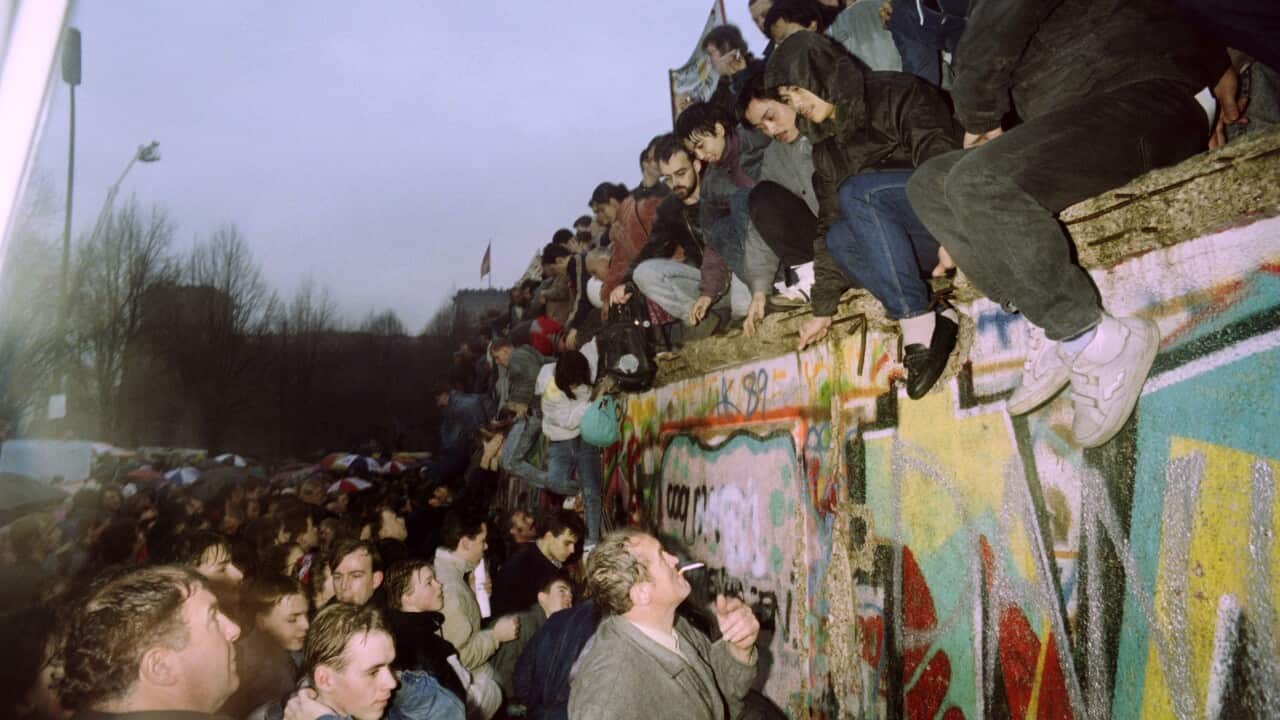Key Points
- The notorious Berlin Wall 'fell' or was opened on 9 November, 1989.
- Thirty-five years later, German Australians and others reflect on the era.
- The German ambassador says the 'peaceful revolution' should inspire people today.
On 9 October, 1989, more than 70,000 protesters marched peacefully through the streets of Leipzig, demanding freedom and reform in East Germany, officially known as the German Democratic Republic (GDR).
The socialist regime mobilised police, secret services, and military forces in the side streets but ultimately refrained from using force.
Just four weeks later, on 9 November 1989, the 155km-long Berlin Wall 'fell' or was no longer operational, marking the beginning of the end for the GDR, and moving towards German reunification.
Sydney lawyer Olaf Kretzschmar was just 16 when he heard the news televised.
He lived with his parents in a small apartment in the GDR, 80km outside Berlin.
“I woke up one morning and saw something on TV," he told SBS German.
"I didn't believe it was true. Because it was, it felt so impossible or so unlikely that this would have happened. And then I went through my day and it was on the radio and TV again and again and again.

A map of East and West Germany before reunification in 1990.
The wall was constructed in 1961 to separate the communist-controlled East, from the capitalist West of Berlin.
It was in fact made up of two walls, both four metres tall and separated by a mine corridor known as the 'death strip'.

Olaf Kretzschmar was 16 when the wall came down. Credit: Supplied
The German government estimates that more than 100,000 East Germans made attempts to escape between 1961 and 1988.
It says more than 600 of them died in the process — many of them shot by East German border guards at the infamous 'Checkpoint Charlie'.
At 6.52pm on 9 November 1989, Berlin’s Socialist Unity Party leader Günter Schabowski made an unanticipated announcement at a press conference, including new travel regulations, effective immediately, which allowed citizens to cross freely into the West for the first time in decades.

People at Brandenburg Gate in the wall on 10 November, 1989. Credit: ullstein bild/ullstein bild via Getty Images
Kretzschmar visited East Berlin with his father before the wall fell, recalling the skyscrapers of West Berlin in the distance.
"(I thought) 'wow, we'll never go there'," he said.
"(The fall was) a groundbreaking thing, even more so that it happened (peacefully) without any weapons being raised."
After the fall, families once separated for decades were reunited while places once thought unimaginable to visit, were once again reachable.
'He started crying'
Sonja Maria Geiger, who grew up in West Germany, was 12 when the wall fell.
A year later, she visited East Germany for the first time with a youth choir.
The choir director, who she described as a "strict old man", took them to his childhood home.
Seeing his reaction, Geiger realised the magnitude of the division’s impact on so many Germans.
"He started crying in front of the door of his father's or his parents' house. And we all realised even being 13 and oblivious of what grown-ups might think, what an emotional moment that would have been for him," Geiger said.
"The whole group fell silent and just watched him."
German Ambassador to Australia, Beate Grzeski, emphasised the valuable lessons learned 35 years after the fall.
"We should remember the courageous men and women who demonstrated months before in East Germany against a then-communist regime," she said.

A man chips off a piece of the Berlin Wall using a hammer and chisel among members of the crowd rugged up against the cold on November 12, 1989. Credit: Roxanne McCann/Getty Images
"The other point for me is that nothing lasts forever. It's good to keep up your ideals, fight against obstacles, although it might take a long time.
"This is not only the case with the German reunification but when you look at Eastern Europe, the Baltic states as well had to wait many years and had to not give up their ideal of freedom and unity. And finally, they also were rewarded."

German Ambassador to Australia, Beate Grzeski. Credit: Supplied
Germany’s reunification on October 3 1990, less than a year after the fall of the wall, was not instantly embraced by all neighbouring countries but ultimately led to a stronger, unified Europe, she said.

